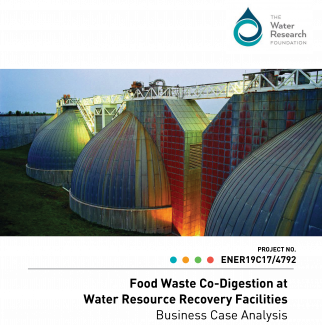
Co-digestion of food wastes with wastewater solids at water resource recovery facilities (WRRFs) can provide financial benefits to WRRFs as well as a broad range of environmental and community benefits. Co-digestion is a core element of the wastewater sector’s “Utility of the Future” initiative, which envisions a new business approach for pioneering WRRFs to create valuable energy and nutrient products via the recovery and reuse of residuals from the wastewater treatment process. With fewer than 1 in 10 WRRFs using anaerobic digestion to process wastewater solids, and about 1 in 10 of those co-digesting high strength organic wastes, there appears to be significant untapped potential for co-digestion. A contributing factor is the various financial, operational, regulatory, stakeholder/political, and organizational risks and impediments WRRFs may face with the adoption of co-digestion and energy generation projects, which are outside core wastewater treatment services.
With the goal of stimulating and informing further evaluation and adoption of co-digestion, this report provides
- A diagnostic framework for WRRFs to analyze the opportunities and business case for co-digestion in their own organizational, market, and policy contexts and, if indicated, to develop a long-term business strategy that advances their mission and long-term goals (Chapter 3),
- Dozens of case studies illustrating strategies WRRFs have used to successfully address the range of risks and impediments they face in adopting co-digestion, as well as WRRF decisions to not co-digest, or to dropout or cutback co-digestion (chapters 4-9, Appendix B, Appendix C),
- Lessons learned from a public policy perspective (Chapter 10, complemented by Appendix A which outlines the wide range of policies that can affect the financial and technical efficacy of a project),
- Lessons learned from a WRRF perspective, including factors associated with successful co-digestion programs, as well as best practices for creating a successful business strategy, and solutions to various widely cited impediments to co-digestion.
- Additional resources for WRRFs to support their diagnosis of co-digestion opportunities (Appendices D-F).
OR CLICK BELOW TO GO DIRECTLY TO INDIVIDUAL SECTIONS:
Chapter 1: Overview of the Report
Building a Business Case: Framework for Decision-Making
Chapter 2: WRRF Co-Digestion: Current Status, Policy Context, Drivers and Impediments
Chapter 3: Framework for Decision-Making to Adopt Co-Digestion
Diagnostic Screening Questions: Assessing Fit, Opportunities and Impediments for WRRF Food Waste Co-Digestion (compiled from Chapter 3)
Case Studies
Chapter 5: Stevens Point Waste Treatment Plant, Public Utilities Department, City of Stevens Point, Wisconsin
Chapter 6: City of Dubuque Water and Resource Recovery Center, Dubuque Iowa
Chapter 7: Clearwater Road Wastewater Treatment Facility, Derry Township Municipal Authority, Pennsylvania
Chapter 8: Central Marin Sanitation Agency Treatment Plant, Central Marin Sanitation Agency, California
Chapter 9: Joint Water Pollution Control Plant, Sanitation Districts of Los Angeles County
Appendix B: Thumbnail Case Study Sketches
Appendix C: Profiles of Feedstock Suppliers
Lessons Learned
Chapter 10: State Profiles: Policy Portfolios and WRRF Co-Digestion Adoption
Chapter 11: WRRF Perspective: Lessons Learned
Resources
Appendix A: Diagnosing the Policy Context for WRRF Co-Digestion
Appendix D: Tools for Assessing the Business Case
Appendix E: Investment Decision-making: Financial and Triple-Bottom Line Criteria and Metrics
Appendix F: Federal and State Programs Providing Grants and Loans
Appendix G: WRF Research Projects on Co-Digestion
The Environmental Law Institute gratefully acknowledges the Water Research Foundation’s financial and administrative assistance in funding the project through which this information was discovered, developed, and presented.